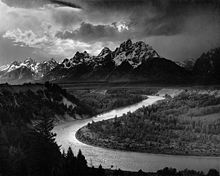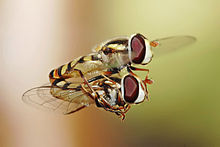- Nature photography
-
 The Tetons and the Snake River (1942) by Ansel Adams
The Tetons and the Snake River (1942) by Ansel Adams
Nature photography refers to a wide range of photography taken outdoors and devoted to displaying natural elements such as landscapes, wildlife, plants, and close-ups of natural scenes and textures. Nature photography tends to put a stronger emphasis on the aesthetic value of the photo than other photography genres, such as photojournalism and documentary photography.
Nature photographs are published in scientific, travel and cultural magazines such as National Geographic Magazine, National Wildlife Magazine and Audubon Magazine or other more specific magazines such as Outdoor Photographer and Nature's Best Photography. Well known nature photographers include Frans Lanting, Galen Rowell, Eliot Porter and Art Wolfe.
Contents
Wildlife photography
Wildlife photography is devoted to capturing interesting animals in action, such as eating, fighting, or in flight. Although usually shot in the wild, game farms are also a frequent location for wildlife photography.
The techniques of wildlife photography differ greatly from those used in landscape photography. For example, in wildlife photography wide apertures are used to achieve a fast shutter speed, freeze the subject's motion, and blur the backgrounds, while landscape photographers prefer small apertures. Wildlife is also usually shot with long telephoto lenses from a great distance; the use of such telephoto lenses frequently necessitates the use of a tripod (since the longer the lens, the harder it is to handhold). Many wildlife photographers use blinds [1] or camouflage.
Macro / Texture
The macro photography article explains close-up photography in general; however, this is also a type of nature photography. While common macro subjects - bees, dragonflies, and so on - could be described as wildlife, their world also makes for good photography.
Many photographers record images of the texture in a stone, tree bark, leaf, or any of other small scenes. Many of these images are abstract. Tiny plants and mushrooms are also popular subjects. Close-up nature photography doesn't always need a true macro lens; however, the scenes here are small enough that they're generally considered different from regular landscapes.
Use of color
 Valley of Fire State Park, Nevada
Valley of Fire State Park, Nevada
The presence (or absence) of color is not a requirement of nature photography. More black-and-white photos are being produced by digital means today than on film in the 1930s.[citation needed]
Ansel Adams is famous for his black and white depictions of nature, which are still held in high regard today. Galen Rowell praised Fujifilm Velvia film for its bright, saturated colors, asking "Who wants to take dull pictures that will last a hundred years?" [2] Both men distinguish between photography as an expressive art form and sensitometry; an accurate reproduction is not necessary.
Ethics
A number of ethical concerns and debates surround the creation of nature photography. Common issues involve the potential of stress or harm to wildlife, the potential of photographers overrunning and destroying natural areas, the use of game farms, and veracity and manipulation in photography.
See also
- Art of Nature Photography Competition
- Cloudscape photography
- Conservation photography
- Landscape art
- Landscape Photography
- Macro photography
- Nature photographers
- Photography
- Project Noah
- Underwater photography
- Wildlife photography
References
- ^ "Blindsiding Wildlife with a Camera" from National Wildlife Magazine - December 1, 2009
- ^ Galen Rowell's Vision, Galen Rowell, ISBN 0871563576
Categories:
Wikimedia Foundation. 2010.



